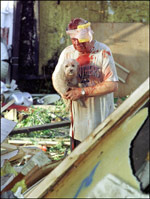|
By Terry Rice Bodies were scattered with debris moments after a tornado touched down and devastated a family campground near Red Deer, Alberta last summer.
Twelve people died, more than 100 people were injured, the destruction massive, but with proper warning it might have been avoided. At least, that is the goal of an innovative new research initiative at The University of Western Ontario that is making weather and the power of nature the focus of its research. The Institute for Catastrophic Loss Reduction (ICLR) was established at Western in 1998. It is an initiative between the insurance community (through the Insurance Bureau of Canada) and Western with the goal of reducing the loss of life and property caused by severe weather and earthquakes. The Institute focuses on four broad objectives: building safer communities, establishing safety partnerships, enhancing industry awareness and promoting consumer awareness. “We’ve learnt over the past decade that the problem of natural disasters is getting measurably worse,” says Dr. Alan Davenport, Research Director for the ICLR. For example, more than four million Canadians have been affected by natural disasters in the last three years. The loss of life and property from events like the 1996 Saguenay flood, the 1997 Red River flood and the 1998 ice storm in Quebec all warn about Canada’s growing vulnerability. In 1998 alone, 28 Canadians died due to severe weather. Governments and insurers paid over $3 billion in claims due to natural disasters. Davenport puts part of blame on climate change and says there’s an expectation with climate change we will see more extreme weather events and earthquakes. Populations are growing and concentrating more in large urban settlements, adding to the problem. Researchers at the Institute are realistic about what can be done. “We’re not putting a bulletproof screen in front of the body as the bullet comes. But we’re hoping to advise and set up things that someone else puts the screen up or hopefully better that the bullet doesn’t get there,” says Gordon McBean (ICLR Chair, Policy for Catastrophic Loss). The problems the Institute tackles have global implications. The United Nations says mitigating the effects of natural disasters is “the most important issue facing humanity in the 21st century.” Under the leadership of Davenport, the ICLR draws on the expertise of eight faculty members from engineering science, three from social science, and one from science and one from the Richard Ivey School of Business. “When we looked around the world and certainly in this country about where we wanted to establish work like this, Western was seen as a powerhouse in terms of the people who were here already. The establishment of the Institute has allowed us to draw even more talent to the University to further add to the credibility to the work here,” says Paul Kovacs, the Institute’s Executive Director and the Senior Vice President and Chief Economist for the Insurance Bureau of Canada. Page Two | |||||||||||||||||||||||||||||||||
| ||||||||||||||||||||||||||||||||||



